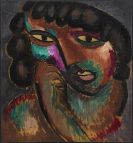
Edward Steichen
1879 Luxemburg
1973 West Redding, Connecticut
The photographer and curator Edward (born Eduard) Steichen was born on March 27, 1879 in Luxembourg but spent his childhood in the US. He pursued studies to become a lithographer, studied painting, and after 1895 studied photography on his own. By 1899, his photographs were already being exhibited.
Edward Steichen became acquainted with Alfred Stieglitz and exhibited in Paris and London, where he became a member of the "Linked Ring" in 1901 because of his connections with pictorialism. In 1902 he was a founder of the "Photo Secession" in New York. He worked closely together with Stieglitz – he participated in the opening of "Gallery 291" and in the production of the journal "Camera Work". In addition, he created portraits of artists and authors.
In 1906 he moved to France, where he devoted himself to fashion photography. During World War I, he worked as a consultant for American aerial photography.
After the war, Edward Steichen’s view of photography changed: he turned away from pictorialism and called for a "straight photography" instead, free from all manipulation.
In 1920 he experienced a calm, withdrawn year in France, gave up his career as a painter once and for all, and returned to the US with the firm decision to become a photographer. At this point, his career skyrocketed: first he worked in the advertising industry, then as the main photographer for Condé Nast Publications, which meant he received many contracts for renowned fashion magazines such as "Vogue" and "Vanity Fair".
Edward Steichen advanced in no time at all to the most expensive fashion and portrait photographer in the US; he made portraits of for example Marlene Dietrich and Charlie Chaplin.
In 1938, Steichen turned away from commercial photography. Between 1947 and 1962, he lead the photographic department of the MoMA and organized over 60 exhibits there, among them the largest photo exhibit in the world to date, "The Family of Man" from 1955. The goal of this pioneering exhibit was "to be a mirror for the essential unity of human beings in the entire world".
Edward Steichen died on March 25, 1973 in West Redding, Connecticut.

Would you like to sell a work by Edward Steichen?
Infos for sellerART MARKET:

Oil on paper, laminated on cardboard, 1913
Post-Auction Sale 1.500.000
More offers >






